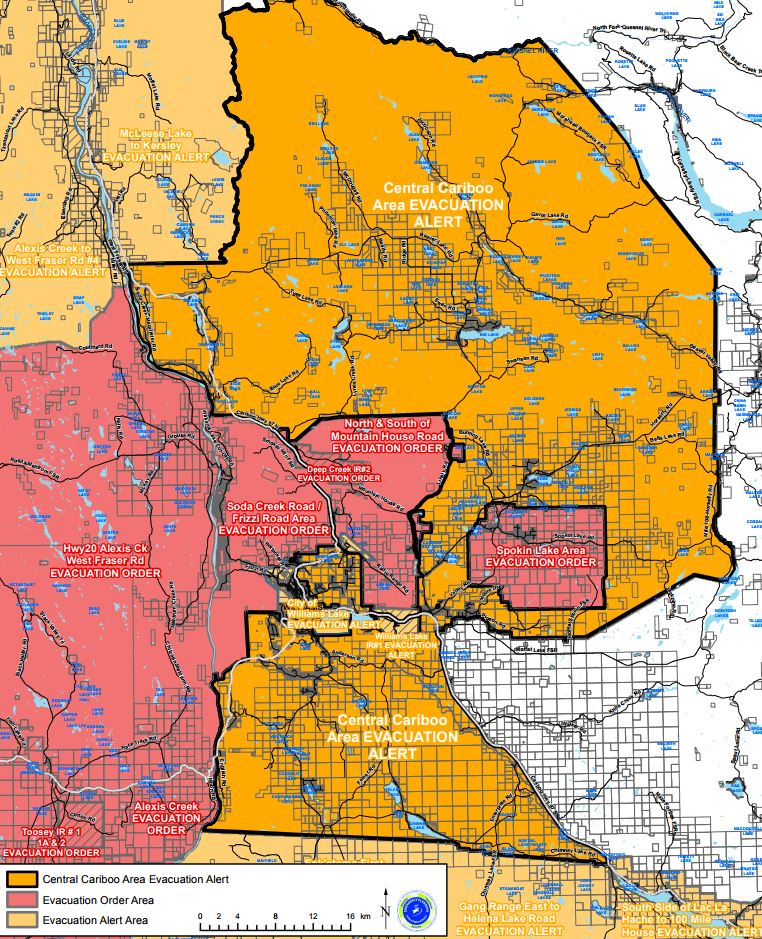Almost two weeks after Williams Lake was ordered to evacuate, the order has been lifted and residents can now return home.

However, an evacuation alert is still in place and residents should be ready to leave at a moment’s notice.
“On behalf of the City of Williams Lake, it is my pleasure to welcome you home,” said Williams Lake Mayor Walt Cobb.
Wildfire activity continues in the area and air quality remains poor. The fires in the region are not 100 per cent contained.
The areas that have been changed from an evacuation order to an evacuation alert include:
- The City of Williams Lake;
- Sugarcane;
- 150 Mile House;
- Fox Mountain;
- Esler;
- Pine Valley; and
- Springhouse (see map below for details about all CRD areas surrounding Williams Lake).
Due to ongoing wildfire operations, evacuation orders will remain in place for the following areas:
- areas north and south of Mountain House Road, including Wildwood;
- the Spokin Lake area;
- areas along Soda Creek Road and Frizzi Road;
- Soda Creek First Nation; and
- areas in the Chilcotin.
What you need to know
The RCMP says residents returning to Williams Lake may do so via Highway 97 from the north and south. Checkpoints will remain in place at key entry points into the city to ensure an orderly and safe re-entry. No entry to areas remaining under evacuation order will be permitted.

Get daily National news
They are warning residents to be prepared for significant delays on travel routes.
The RCMP have been patrolling evacuated areas 24 hours a day, seven days a week to detect and deter criminality. Anyone who has concerns upon return to their home, are encouraged to report any issues to the non-emergency line for the Williams Lake RCMP at 250-392-6211.
If you require assistance with your pets, the SPCA continues to offer their assistance and can be reached at 1-855-622-7722. Livestock questions/assistance requests should be directed to the BC Cattleman’s Association.
The residents of Williams Lake were ordered to leave their homes on Saturday, July 15, due to a number of wildfires burning in the region.
MAP: Where wildfires are burning around B.C.
Thousands of people left Williams Lake although some stayed behind. Evacuees were asked to go to Kamloops and register there.
But it has been a tense 12 days for residents, waiting to find out when they can return home and what they will be returning to.
READ MORE: Williams Lake business owner anxious over mounting costs of evacuation
In the past week, workers have been let in to Williams Lake to make sure the city is ready for people to return home.
Before residents can come home, officials needed to be sure that Highway 97 north and south of the city is safe, and that the fires themselves no longer present a danger, Mayor Walt Cobb said on July 23.
Officials allowed some people to return to prepare grocery stores, gas stations and a drug store for residents as well.
What to do when returning home after an evacuation
The B.C. Safety Authority has put out some tips to residents who are returning home.
“We know everyone has been through a very difficult period and people are anxious to get home. For safety reasons gas and electrical equipment exposed to fire or water should never be turned on without being inspected by a licensed contractor,” explains BCSA’s Brad Bice, director, operations, safety system operations.
Here are the top things you need to know before heading home:
- Wait for instructions – The decision to lift an evacuation order is made by local fire officials in consultation with other agencies. Before returning to your home or business, ensure it’s been declared safe to enter by proper authorities. Be patient: Most districts will need to first conduct a comprehensive assessment to ensure the integrity of infrastructure and utilities, including water, sewer, roads, hydro, natural gas and emergency telephone services.
- Know the reconnection requirements – In most areas directly impacted by the fires, your local gas and electrical utilities may have turned off your connections. If your gas meter or gas supply has been turned off, do not attempt to turn it on yourself. Call your local utility or supplier for further guidance.
- Be appliance aware – Any electrical, gas or heating equipment subjected to fire, or to water as part of firefighting efforts, should not be plugged in or turned on. This includes furnaces, boilers, ovens, refrigerators, gas barbecues, etc. Call a licensed gas or electrical contractor to inspect it first.
- Use a licensed contractor – It’s always important to use a licensed contractor when having gas or electrical work done, but it becomes particularly important after a natural disaster due to potential issues around safety, home insurance and liability. Typically, homeowners can pull homeowner permits and complete minor gas and electrical work themselves, subject to inspection by BCSA. However, in the case of natural disasters this is not permitted.
- If in doubt, get out – If you smell rotten eggs, it could be a natural gas or propane leak. Stop what you’re doing and do not create any source of ignition. Do not use your cellphone or landline and do not operate electrical switches. Exit the premises, leaving the door open behind you. Once outside call your gas utility, propane supplier or 911.
Also stay aware of carbon monoxide (CO), which is a colourless, odourless, toxic gas produced when fuel-burning appliances are not functioning properly. To learn more about the symptoms of CO exposure, visit the CO page on BCSA’s website.
-With files from Simon Little









Comments